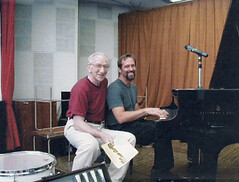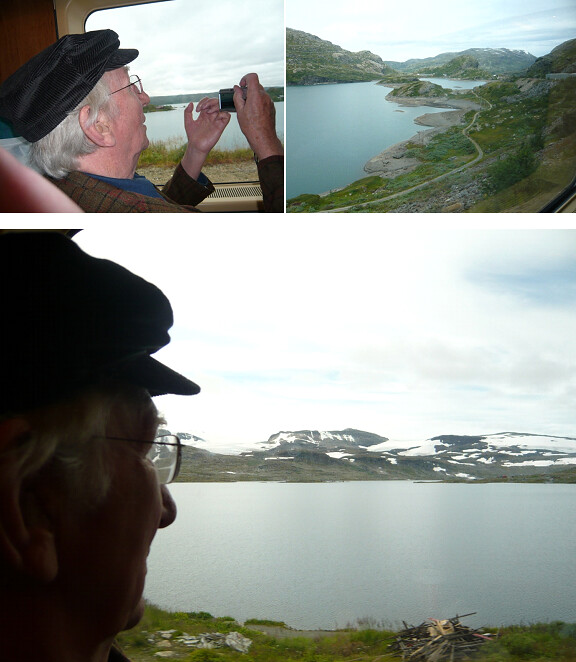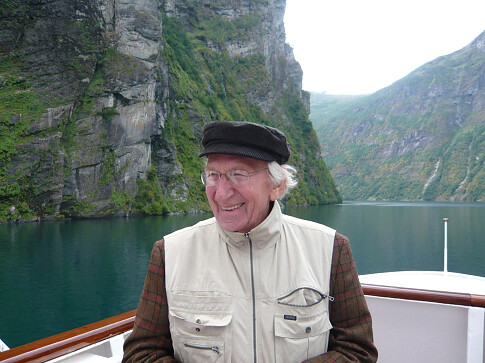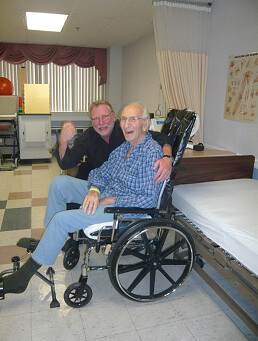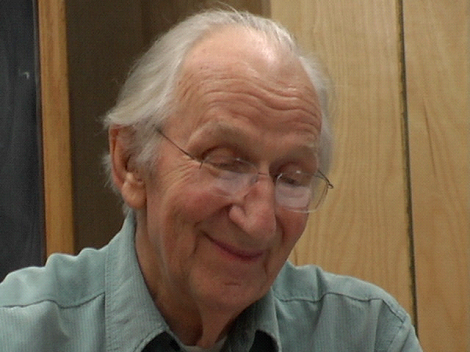Special Section: In Memory of Clive Robbins 1927-2011
Clive’s First and Last Trip to Norway—And Something Between and After
By Tom Næss
A baker’s son, Clive Edward Robbins was born on July 23, 1927, in Birmingham, England and died after an adventurous career in the field of music therapy in his home in New Jersey, December 7, 2011.
The First Trip
Email from Clive June 21, 2011:I want to tell a couple of things: When Paul and I began our work as Lecturing Fellows of the American Scandinavian Foundation our first work was in Copenhagen. So I packed up the old Rover and we drove to New York to sail on the Bergensfjord, car and all. We didn't know it at first but as luck would have it the boat first made a stop in Bergen. We were up early that morning and approached Bergensfjord in a misty fog. We found ourselves sailing slowly between tiny rocky islands. They got bigger and then there were more of them. It was magical then as the mist lifted and we found we were quietly entering a fjord. There were little summer cottages on the slopes of the fjord, and as it widened, the PA system began playing the Grieg A minor Piano Concerto. So we arrived on this big (unknown and all-important) Scandinavian project with the magical beauty of Norwegian nature and the beautiful music of Norway. I think we stayed a day in Bergen, then sailed down the coast to Copenhagen.
At that time the movie "Hans Christian Andersen," starring Danny Kaye, was a big international hit and as I looked quite like him in some ways I was sometime mistaken for Danny Kaye in Copenhagen.
We returned to Norway, Oslo, after our first two weeks in Denmark, and the rest is history, beautiful history.
It is typical of Clive, with his wonderful memory, that he can remember such rich details – even at 84 years of age - from his whole life and present those memories as a poet. Another specialty is his everlasting humor and informal way of being, loving to tell funny stories like the one above.
After having been a friend with Clive for 40 years, I will try to fill in some facts and some personal elements into this beautiful history.
Scandinavia—and Particularly Norway—From 1968
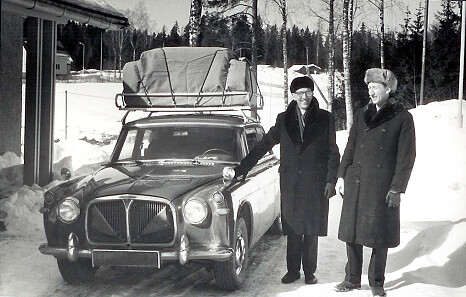
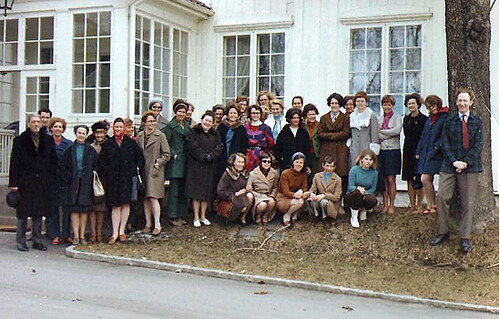
The American-Scandinavian Foundation made it possible for Paul and Clive to visit Denmark, Finland, Sweden, Norway and Iceland. Here they gave lots of demonstrations and lectures in this mostly unknown field of music therapy from 1968.
Clive Robbins writes: “Ellen Boysen attends our course in Copenhagen. (1969) This was important as it was the key to future development in Norway.” As at result of the contact with Ellen Boysen who was working at the Institute for Cerebral Palsy at Berg Gård Oslo, Paul and Clive came over to hold a 2 week-course here.
In Norway particularly, Paul and Clive felt a professional and personal affinity with the people they met. Their work received immediate and warm acceptance. The improvisational approach with its creative humanistic values, and the sheer musicality of their work, gave it this immediate appeal. Between 1968 and 1973 they lectured, demonstrated the work, and gave workshops at Klæbu Institute, Trondheim; Emma Hjorts Hjem, Sandvika by Oslo; The Norwegian ministry of Health; Oslo Observation Centre for Severely Retarded Children; Bleiker Psychiatric Treatment Centre; Holmenkollen Day Centre and School; The State hospital; Berg Children’s centre for Cerebral Palsy, Oslo; The Child Psychiatric Study Group at the University of Oslo; Norwegian Academy of Music and Barrat Due Music Institute, Oslo. At the latter institution they gave well-attended presentations in 1971, there were serious discussions about a two-year training program beginning in 1972 or 1973. However lack of founding prevented this becoming a reality. (Næss, 2008; Simpson 2009)
Paul and Clive wrote the following passage after the lecture tours and having taken part in our National day the 17th of May:
This was a stimulating way to get a feeling of Norway and Norwegians. We felt immediately a living affinity between the practical origins of our work and that was native to the Norwegian spirit – the wish to do things with the children was the same, and the intuitive values coming to expression in the mode of approach had a very familiar feeling. (Næss, 1989, p. 8)
Paul and Clive earned a generous grant in 1971 from the German publisher Axel Springer that enabled them to take a year off in Denmark, away from lecturing engagements, in order to write a comprehensive resource textbook for musicians training to become therapists. This was eventually published in April 1977 just after Paul’s death, under the name Creative Music Therapy (Nordoff & Robbins, 1977)
I was so lucky to be invited by Paul and Clive in the house they were living and writing at Kirke Vaerloese in Denmark in 1972. I brought a tape from my work at Emma Hjorts Hjem where I had started a growing music therapy practice since 1971. All three of us were excited that we found that our common tool in the music therapy work was improvisation. And we felt immediately that our work was in close family relation, and a mutual lifelong friendship and exchange relationship was established.
The familiarity of our music therapy work resulted in Paul and Clive’s decision to open their book Creative Music Therapy with two case examples from my work at Emma Hjorts Hjem. This work was so meaningful to Clive that he wanted it to also begin the second edition that he worked on for years revising and expanding the original work which was eventually published 30 years later in 2007. (Nordoff & Robbins, 1977; Nordoff & Robbins, 2007)
A Two-Month Course at “Killingen” Emma Hjorts Hjem Near Oslo
Our collaboration and friendship led to a two-month training course that Paul and Clive held in the building Killingen I was so lucky to be able to use for music therapy work at Emma Hjorts Hjem. This course, held in the fall of 1973 was the longest Paul and Clive had ever taught. With sixteen students from Norway, this course had all the seeds of forthcoming training program at Goldie Leigh Hospital in London. The therapy room was modified to incorporate a large removable one-way mirror for observation purposes, and the way Paul and Clive taught became the model for London. (Simpson, 2009, pp. 29-32)

Goldie Leigh 1974
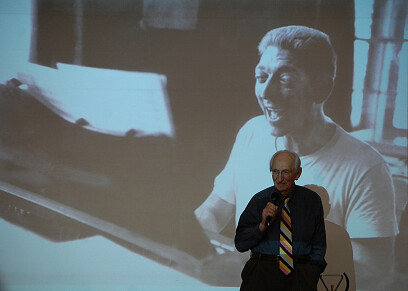
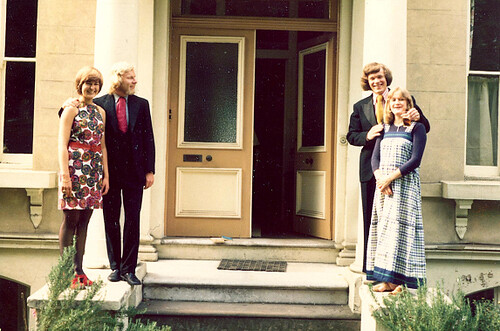
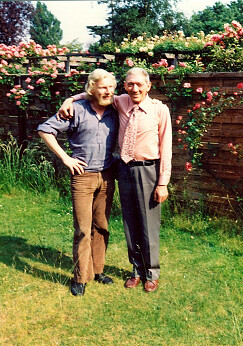
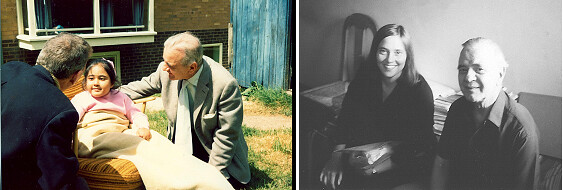
In this course, among students from different part of the world we were four Norwegian students that followed Paul and Clive over to England to train at Goldie Leigh Hospital, London in 1974: Sissel Holten, Unni Johns, Knut Onstad, and me. It was a huge experience for us in many ways: Paul’s discussions of music, playing piano excerpts (without any sheet music) from all periods of the classical piano repertoire with a variety of composers from Bach to Schoenberg; Paul’s rich and touching improvisation and the impressive clinical work they both demonstrated live and by tapes; and the radiation, human closeness, sensitivity and warmth and often playful communication Clive always was incorporating into relations both with the clients and us students.
To study with this legendary music therapy team in London in 1974 was an enormous enrichment that I could have written a whole book from: Endless thanks, dear Paul and Clive. (Næss, 1989).[Ed. Note: This course was the basis of the book Being in Music: Foundations of Nordoff-Robbins Music Therapy by Kenneth Aigen]
Every minute of the course was taped and Clive and Carol Robbins later edited Paul’s “Talks on Music” into the book Healing Heritage: Paul Nordoff Exploring the Tonal Language of Music (Robbins & Robbins, 1998)
When studying at Goldie Leigh, we Norwegian students were given the opportunity to visit Paul’s and Clive’s mentor, Dr. Herbert Geuter (Hep) who still was living and working at Sunfield Children’s Homes (Worcestershire in England) where Paul and Clive started their collaboration in 1958. Dr. Geuter was a very special man. When he met us he was talking like an oracle giving everyone of us very personal Wiseman’s words. He also pointed out a special place in the room that looked like a salts and said: “Here was Pif Paf Poltrie born”. When Paul came to Sunfield for the first time he started to make music to this fairytale from Grimm called Pif, Paf, Poltrie, while Clive was working as a special education teacher. At that time he adapted the fairy tale as well as was making song texts to be used for his special class. This working play for children was the first project Paul and Clive made together under the supervision of Herbert Geuter. This was also the beginning of their collaboration that later would become an adventurous music therapy career. Clive told me a few years ago: “Creative Music Therapy was born out of the work with Pif.” (Nordoff & Robbins, 1971).
The start of the Norwegian music therapy training course
Coming back from the Goldie Leigh course, I started formal studies in music and music education at the Norwegian Academy of Music. Here I joined a committee consisting of Even Ruud, Harald Jørgensen, Joar Rørmark and Steinar Stolpe. The aim of this committee was to make a curriculum for a four-year training course in Music Therapy at Musikkhøgskolen (Norwegian Academy of Music). The Academy never secured the finances to start this program. However, Even Ruud made a draft from this plan which made it possible—largely due to the goodwill from the principal Per Selberg—to start a two-year music therapy training program at Østlandets Music Conservatorium in the fall of 1978.
Together with Even Ruud—our dear, hardworking “locomotive”—and Unni Johns we initiated and started teaching at this program. Since Unni and I were two of three main teachers that were educated as NR therapists, it was natural that this education has been significantly influenced by the Nordoff-Robbins approach. My colleague Even Ruud, educated as a music therapist in the US in the early seventies, has always been supportive and positive to the Nordoff-Robbins approach and we have had good cooperation since the beginning of seventies until the present day. (Næss & Ruud, 2007 & Ruud, 2010)
Clive was invited back a number of times to Norway with his wife Carol, in 1978, 1979, 1981 and 1994, teaching in Oslo for the Norwegian Association for Music Therapy, at the special Teachers’ College and at Østlandets Musikkonservatorium. It was a great loss that Carol died in 1996 at only 54 years old.
Clive continued to keep in contact with us Norwegians and was later honored at the twentieth anniversary of the Østlandets Musikkonservatorium training program in 1998. He returned again in 1999 to teach at Norway’s other music therapy training program in the university college in Sandane in Western Norway (now in The Grieg Academy at the University of Bergen), which in 2004 began engaging in collaborative research with the Nordoff-Robbins Music Therapy Centre in London.
For many years, students and teachers from our music therapy community came to visit Clive and the Nordoff-Robbins centers, both in London and New York several times.
Building Bridges between Clive and His Colleagues in New York and the Music Academy in Oslo
Since Clive was living in New York, visits to New York University (NYU) and the Nordoff-Robbins Center happened regularly. Often we teachers from Norway brought our students with us. At these occasions we met and were taught by Clive and his creative and skilled staff including the eminent music therapists and leaders of the Center; Ken Aigen and Alan Turry, the current leader.
We always went home to Norway filled with lots of knew knowledge and inspiration. Karette Stensæth was among music therapy students from Norway joining our visit to the NR Center in NY 1994. She is now my colleague and we are currently writing and article for an anthology called “Musical Life Stories.” She brought into the article a quotation from an oral presentation of Clive’s work he held for us at the Center: “Music therapy is in its essence a celebration of the unique child! It is about holding the child in the palm of your hand, lifting him/her up and showing the world around what he/she can do.”
The NR Center is part of New York University and I have been fortunate to be introduced to Barbara Hesser who is the leader of NYU’s Master’s Music Therapy program.
Barbara has been of enormous importance not only for the Center and NYU but also for all visitors from Norway. My impression is that she has lived a core role both professionally and socially for the total music therapy environment here. When we Norwegians came over to NY, Barbara always generously opened her apartment which was comfortably situated near the Center and NYU. Here we met with Clive, who was living in the same block and often dropped in, and many of their colleagues. Her apartment is not big, but as we say in Norway: “Where is heart room there is houseroom,” and at Barbara’s there is both. From time to time I have an association that this apartment high up in that block is a kind of social nest where everyone is welcome to share problems and happiness both on private and professional levels.
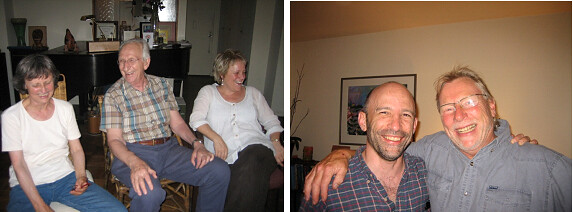
Personal and professional contacts were made to Barbara, colleagues and her husband, Peter Jampel. Peter was, like me, having a band with members of clients as a part of his music therapy practice. We have had huge experiences visiting him and his impressive band at rehearsals at Baltic Street Clinic. As a result of our collaboration and friendship Barbara and Peter came over to our Norwegian Academy of Music to make an enriching teaching in Oslo 2006.
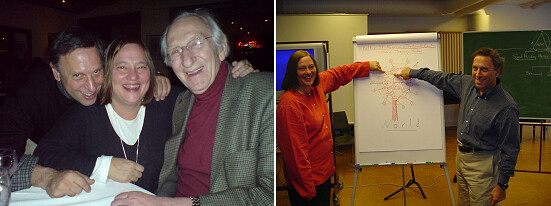
Another important collaboration and friendship growing out of the contact with Clive and the New York NR Center was with Dan Gormley. My students were taught by him in New York and he has twice visited Norway teaching both at the music therapy program in Sandane (now Bergen) and in Oslo. From his background of using electric guitar and band instruments for years in the service of music therapy, he has made foreword in the book by Næss & Steinmo (2007) Pop and Rock with Colours. Dan is further described in the section of this paper where Clive is interviewed.
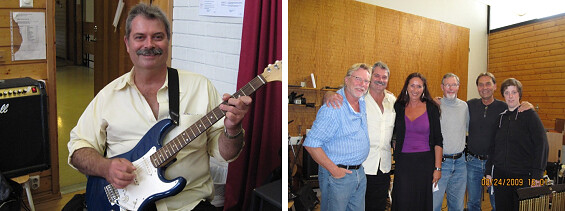
First International Clive Robbins Research Symposium and 80th Birthday Celebration
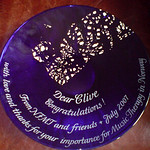
Clive turned 80 in the summer of 2007. For that occasion we were invited to the First International Clive Robbins Research Symposium and 80th Birthday Celebration.
One of the greatest events here was that Clive could present a complete new version of Paul’s and his life’s work Creative Music Therapy with the new sub-title: A Guide to Fostering Clinical Musicianship (Nordoff & Robbins, 2007). I was given this book as a gift with Clive’s personal inscription which I am so grateful, proud and shy to show: “For my dearest, kindest, friend and colleague, Tom, Celebrating 35 years of sharing, growing, creating together. Clive.” I had been asked to hold the final speech in the program “Honoring Clive Robbins” at the symposium. So I did, and conveyed a present on behalf of the Norwegian Association for Music Therapy. This was an artist’s handmade cobalt glass platter with silver ornament and engraved the following text: Dear Clive, Congratulations! July 2007. From NFMT (Norwegian Association of Music Therapy) with love and thanks for your importance for Music Therapy in Norway.
Interview of Clive at his 80-Year Celebration
When I came to celebrate Clive’s 80th birthday in New York, I brought with me a wish from the Norwegian Association for Music Therapy of interviewing Clive. So I did. We met at the NR Center at NYU and sat down in the therapy room with the video camera rolling. We made an interview of nearly 40 minutes. Excerpts from the interview were printed in our Norwegian Music Therapy journal in Norwegian (Næss, 2007). It has never been transcribed into English, so I am taking the opportunity to put a shortened excerpt of that into this text:
Tom: What are your main lines of thoughts within music therapy?
Clive: Ok! You know, when we first started this Clinic, we made sure the cameras were working, the pianos were in tune, the instruments were good, and I used to think of this Center like a kind of an aircraft carrier, and all the therapists were pilots, and they flew their missions. Once they were in their plane and took off, they were independent; they were doing what they had to do in the way they had to do it. They were free. And we were here to serve this individual creativity in the therapists. So the therapist really is an artist. A music therapist should consider themselves as artists. Not that you are conceited or proud or vain- because you are an artist- but because you are going to live with art. And it’s a double art. It’s the art of music, and you are using the art of music in the service of the art of healing. And every client is a kind of journey, it’s an adventure. You need to get into that particular text, that particular narrative that the client is going to present to you: The challenges, the qualities, to bring things out of you - but also to bring to you - and to challenge your musicianship and your humanity. So that really is a great basic thought. So you need to be creative, you need to be resourceful; you need to be on your own paths of growth and development. And you must learn from your clients: Let them teach you!
In many ways, Clive confirms that his developmental process is much about learning:
C: I was continually learning new things all the way through, from 1959 when we began to the 1970s when we began to lose our clinical work, but we were writing. I learned from writing about the work. I learned from the tapes. And then of course I learned from my work with Carol and then I learned from my work with colleagues in England and here (in New York) and from you in this earlier works when we saw you working at Emma Hjorts Hjem at Killingen: Your work with Bent; there was more to be learned. In a way there was learning more of the same, but broadening and changing.
Clive also thinks it is not only important to learn from others. But to have your own authenticity:
C: But also your, the therapists, own authenticity is very important. You can learn from others. May be you can learn something by watching Øyvind, I don’t know – or the techniques we use, that’s fine! But it is how you do it with your quality, your sense of the presence of the immediacy. That’s so important! And your creativity: Only you can give birth to your music in the creative moments inspired by the client.
I think this attitude shows that Clive advocates an anti-dogmatic and widely individual approach within the NR approach. One example is while Paul only wanted students with piano as their main instrument, the Center in New York where Clive had his base, has been open for students with other instruments. Therapists like Dan Gormley have been studying at the NR Center with electric guitar as his main instrument. There is a link between a person’s authenticity and the instrument that is part of his identity.
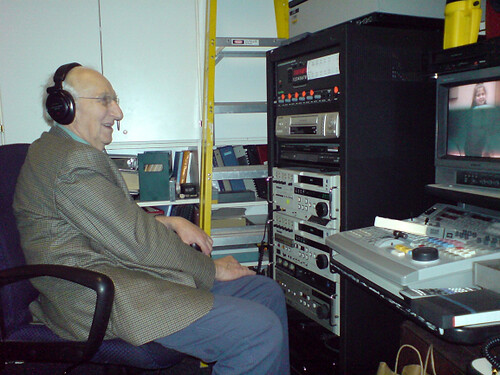
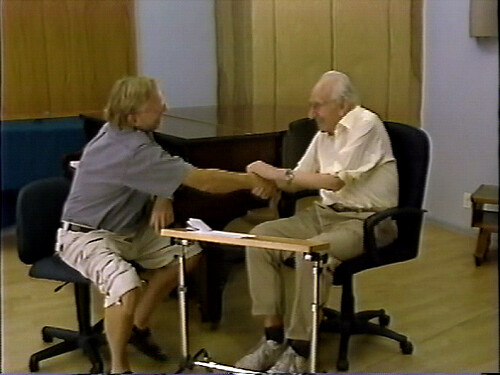
Clive was eagerly speaking of how much they learned from the tapes of their clinical work. It has been of core importance. And we can state that without Clive’s technical interests and ability to work with auditory and later visual recording equipment, - and his fundamental effort and thorough work of taping and systematically saving this into archives- there would have been no Nordoff-Robbins approach.
Clive further discusses the challenge of doing music therapy in a society overfilled with music, and that children and all clients nowadays are “over-entertained”. He is also engaged in relating to a world that is changing rapidly and a world with elements of terror. September 11th was only six years past and he and Barbara Hesser saw from Barbara’s window the twin towers collapsing not far from their homes and the Center. Clive has no specific solutions to these items in the new world, rather stating them as challenges.
We touched on lots of other topics in this interview, including the fact that Paul and Clive made a documentary for the Norwegian Broadcasting Corporation of their clinical improvisation in the film “Øyvind kan slå på tromme” (Irvin can beat the drum) made at “Holmenkollen daghjem og skole” (Holmenkollen daycare centre and school) in Oslo.
T: Was this the only film that has been made of yours and Paul’s work?
C: The film was made in 1971 and was broadcasted in 1972. I think it also was one of the first documentaries ever made about music therapy. I know of nothing before that. And it was designed as a documentary of music therapy. And I think when you see that film, you should realize that everything from the moment it starts is improvisation. Everything …. I think it is the best film of Paul at work. The BBC have made several and they are good, they are very good and quite unique and he says things for example about parents and children in London that he was not called upon in to say in “Øyvind kan slå på tromme”. But in a way we were very free with Øyvind, and I think to my mind it conveys the quality of the clinical work very closely.
T: What has Norway meant to you?
C: I always felt warmly at home in Norway. I liked Norwegians. I like their warmth. They seem to be very straightforward people and quite courageous. Very warm hearted and wanted to act out of what they enjoyed doing. I always enjoyed being in Norway. I like the warmth and the humor…. Pif Paf always went well in Norway. He was comfortable there.
T: We love Pif Paf. It is translated to Norwegian and we use it very often.
C: Well you see. It is a story about people - working! About a farmer, about someone milking the cow, chopping wood. There is no queen or princess or magical thing in it. I remember when we did it in Norway, we did a Pif Paf in Emma Hjorts Hjem after the snow would come. We had to go out in the snow: I went out with Sissel and we cut twigs. And then I went out with Ida and we gathered leaves, I think. So I’ve got such fine fun memories of working in Norway.
T: You are 80 years old this year. What are your main thoughts when you now are looking back?
C: Amazement, amazement that it has worked out like this - that this has happened, that my life goes on this track. I’ve had a wonderful life. I have worked with marvelous people. I’ve made a lot of mistakes. But when you make mistakes in life, they very often are not mistakes, but ways of learning. (Hold up his index finger) – Hopefully. I am grateful for the opportunities I have, for the friends I have, for seeing so much of the world as a music therapist. It’s just all together unbelievable. But it’s believable, so it’s real.
I think life should be a celebration. Life is a gift. And everything that is good and healing and noble, beautiful, kind and loving is to be celebrated - and valued.
T: Thank you very much Clive and congratulation!
C: Thanks Tom. Thank you!
30 Year Anniversary in Oslo 2008
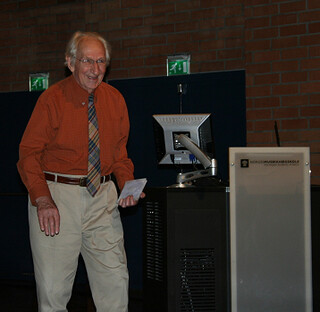

The congratulations to us and speeches full of gratitude to Clive would never end that evening.

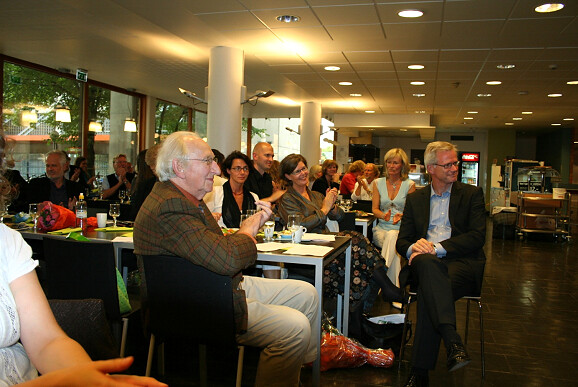
Due to the amazing influence Paul Nordoff and Clive Robbins have had on the Norwegian music therapy adventure since the 60s, in the fall of 2008 Clive was invited as a guest of honor to celebrate the 30th anniversary of the foundation of Norwegian Music Therapy Educational Programs.
On the 29th of August in a packed hall, our great concert hall “Lindemanssalen” at the Norwegian Academy of Music in Oslo there was a warm, joyful and successful 30th anniversary. Clive’s guest of honor speech was full of love declarations and gratitude to the Norwegians and their Norwegian music therapy movement. His speech was also filled with pictures of friends in the good old days and video excerpts, as ever showing unique clinical work with skill and love for the client and the music. Also he warmly declared his appreciation for Norway and all what the country and its people have meant to his life.
Norwegian Goldie Leigh reunion
The next day we had an extraordinarily joyful reunion with Clive and the four Norwegian students from the very first Nordoff Robbins course at Goldie Leigh in London in 1974. We met at my house at Nesodden by the Oslofjord sitting outside barbequing in a sunshine competing with the radiation of Clive. Clive told of what core importance this course in London and its students have become to his life, and he was discussing 1974 as if it was yesterday. When I declaimed my admiration for his fantastic memory and at the same time had to admit I suffered from “teflon-brain”, Clive commented: “Whoa, you have teflon-brain, - that must be easy to keep clean!” This is just another example of hundreds of Clive’s trademark statements: Being positive and optimistic to everybody and everything often mixed with a warm humor.
Clive leaves no doubt about his pleasure of having had a reunion with his four Norwegian students at Goldie Leigh 34 years later, as he writes in his email from September 18, 2008:
It was just SO WONDERFUL to be with you all. Very special, A super peak experience! Joyful, completely happy, exciting, heart warming, and just perfect that we could be together, I can't squeeze the joy I feel into words—I send an enormous cyber hug.
For me it was a spiritual gift that you all came to London. You enlivened the course so much—and with it my life...
But my darlings, you are all so special to me, you put a great strong energy in my heart.
Yours, Clive
Over the Mountain by Train
Then Clive and I had a train ride over the mountains to Bergen. Clive was astonished by the nature as we climbed over the mountains between east and western Norway. He took “tons” of pictures from the train window. At the age of 21 (from 1948 to 1950) Clive studied art at the Camberwell School of Art. (Nordoff & Robbins, 1968 ) Maybe the interest for visual art and photo has its roots here? On this trip Clive was studying the art of nature.
Bergen

Bergen! Here we come!

Bergen welcomed and honoured Clive with a surprising warm and sunny weather for these early September days. We went to the Grieg Academy where we were met by just as warm and shining people as the weather outside. We held workshops and there were reunion with pioneers of music therapy from the ladies that had pioneered music therapy since the 60s and the 70s, to more of today’s active and younger pioneers like Ida Margrete Gjul, Randi Rolvsjord, Cochavit Elefant (Norway/Israel) and Brynjulf Stige. There were inspiring music sessions and warm personal meetings. Brynjulf Stige has written more about that in Voices. (Stige, 2012)
Into the Fjords
After heart-warming meetings, Clive and I went on the cruise boat trip with “Hurtigruten” to the inner filet of Norwegian fjords: Geirangerfjorden. We had both fun and serious conversations sharing more and less secret stories from our lives in the late night hours on board. On the next day when sailing into Geiranger, it was quite misty weather. But my prayer was heard and as we passed the waterfall “The seven sisters” it started to clear up, so we entered Geiranger in a blessed sunshine! Clive was filled with vitality and almost childish amazement, and we both took another “ton” of pictures.
Email from Clive 31 December 2008:
My computer opens with a gorgeous picture taken in Geiranger fjord at the last left turn immediately before the last right turn into the town of Geiranger—remember how the sun struggled through just at that time! So every day I am reminded of that wonderful time.
Am cooking dinner right now, so I'll come back later. Oceans and mountains of love,
Clive
Clive was so filled with all the experiences from this trip to Norway that I have “mountains” of emails where he for years expresses his gratitude for this trip:
Email 1 January 2009:
I think a good Norse troll cast a loving spell over me. I can’t tell you what a continuous peak experience that visit was. I have to say simply that it was the fulfillment of all my life work in Norway.
Email 3 August 2010:
Although I have to recognize how much I really enjoy my times away, and particularly the big two months teaching trip I did from March to May this year—also, our days in Norway in Oslo, Bergen, the Fjords and the mountains when I came over for the 30th Anniversary Jubilee. That was heaven.
I am so proud and happy I could share this “heaven” with Clive in Norway.
2009: The New York Nordoff-Robbins Center in Economic Trouble
In the nearly 40 years I had the pleasure of knowing and being close friends with Clive I had never experienced him other than optimistic. But in 2009 he became depressed and worried about the existence of the NR Center in New York. The music industry, which had economically supported the Center, collapsed because people stopped buying CDs, and instead downloaded music from internet. The hard working staff of the Center were doing what they could to revive the NR Foundation, but with limited success.
Clive wrote in an email 1st of June 2009:
Sorry to write such a depressing letter, but that's the reality, the way things are. You know I'm normally so optimistic, so upbeat and positive, but it feels inappropriate to be anything but really sad about our situation.
It's hard to reconcile that in the late stages of my successful, productive life I am faced with this beloved Center, in many ways the pride of my life, closing and ceasing to exist. How can it be! We have so much to give, so much more to explore, so much to contribute and share. Still we have another year to hope, and continue being positive and productive—what else is there to be, as a creative music therapist!
The NYU NR Center has survived since that time, and luckily Clive did not experience in his life time that the pride of his life had to be closed. It is hard for us Norwegians to fully understand the difficult situation. We are having another economic, educational and social system that is built mainly on economic support from the Norwegian state. With help from the state, or whatever ways, I do hope there will be found solutions for the further existence for the excellent and valuable Nordoff-Robbins clinical practice and training. I also hope that every possible person or institution can help the continuity of what Clive and all his excellent staff have been building up.
2010: The Grand Finale
The two month teaching trip that Clive took during March to May, 2010 that Clive refers to in his mail of 3rd August 2010 includes an enormous teaching list which I have in front of me and that makes me exhausted just to look at. It includes USA, Tokyo, Kyoto, Beijing, Seoul, Hong-Kong, Singapore, Prague, England and Poland. Clive called this his Grand Finale.
At the Hospital
During the fall, 2010, Clive got very serious health problems. In December he was at the hospital for a longer period and nobody would dare to believe he could come home again. Therefore my wife Astrid and I went over to visit him at the hospital in New Jersey. I thought I would rather come and give him flowers when he was alive instead of at his funeral. When I first saw him at the hospital I thought I saw a man that had little time left. We brought flowers, a big Norwegian smoked Salmon filet and Aquavit (which he did not dare to drink at this stage), a photo gallery book filled with the warmest and best pictures from Norway, a CD player with headphones and CDs. He was very happy to see us and gradually got some of his old spirit back. He was eating the Salmon with an enormous appetite. His wife Kaoru was also there, and was visiting him every day and made an enormous effort on Clive’s behalf. He gradually got more energy and motivation and made some nice progress with the physiotherapist while we were there. And since it was Christmas, Clive was making fun pretending he was a bicycling Santa Claus sitting training on his pedal machine. We had so much FUN together and were laughing and joking. When we left Clive’s room we put headphones on his ears with classical music. The last picture I have of him in my mind, is that he is lying in bed smiling, humming and conducting Grieg!
2011
The response did not wait to come from Clive, in an email 1 January:
Thank you so much for the incredible visit. It was an explosion of love and fondness and generosity. The smoked salmon lasted a long time and was enjoyed by many people and I heard the music with great pleasure. But your loving spirits were a real tonic…. I am doing well they tell me. And I could be coming home next week. (I am home visiting for the day today)
The unbelievable had happened: Clive recovered, came home and something happened that nobody would have guessed:
The 14th of February 2011 he writes:
I am doing well. I began teaching at NYU last Thursday. Kaoru drove me in and stayed for the lecture. It went well and there were no worrying aftereffects. It felt so marvelous to get back into the business of NYU and see all the young people busily going around their lives. And to get back into the Center was a very powerful experience--to reconnect with all the energy, vision, and purpose of my life. So I expect to be teaching again this Thursday.
Clive started to teach again! He was regularly teaching on Thursdays and proved that he still was a hardworking man like he always has been. He had all his life loved to teach and work within the field of music therapy. Still he was able to do so in his last living year.
The 28th of April 2011 he writes:
I'm still teaching one class a week and it goes well. I'm still convalescing. I'm not traveling and lecturing any more, and feel that that part of my life has most probably finished. I've turned down invitations to lecture that would have meant traveling to California twice, Kentucky once and Korea and New Zealand once.
Interestingly, I find myself thinking about what to do with the rest of my life. I know I should get more of Carol's work published, I really I have to do this—and find a way to do it. The archive and equipment are in the Center, but I can no longer use the train and climb the four flights of stairs out of the 9th Street Station. (I can climb stairs, but not so many)
Clive was thinking of what to do the rest of his life. And found some more work to be done! If he was able to work anything with Carol’s work I don’t know, but may be colleagues at the Center can pick up that thread?
Clive keeps on teaching through the very hot summer in New York:
The 31st of July 2011 he writes:
Last week we had a summer course at the Center, and I did two sessions. I'm not as well-organized as I used to be, and I tend to ramble—stream of consciousness—kind of thinking, but people seem to enjoy what I do--and Alan [Turry] is there as a back-up. This coming week we have another course, and will do sessions on Thursday and Friday.
The Fall and Winter
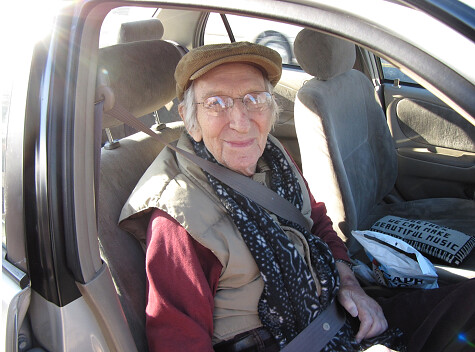
In August of 2011 I got an email with these opening words “Ok, I surrender.” There was serious trouble with Clive’s medication that also caused psychological problems. He had to go to the hospital again. With different medication the psychological problems were solved. But there were lots of general health problems that caused long stays in the hospital and made him gradually weaker. The last email contact we had was in September. But we had several nice, warm and still humoristic phone calls. The 7th of December I felt strongly I had to call him. I was just opening my computer first to check if there was any news. I had got a mail from Barbara Hesser saying that Clive had passed away.
In December, Ida Margrete Gjul, who studied at the NR Centre in London in 1983-84, went from Bergen in Norway to visit Clive in his home in New Jersey. She wrote one of the memorials in the Norwegian Music therapy Journal (Gjul, 2011) and has given me permission to translate excerpts of this to present here:
I have just been visiting Clive and Kaoru in New Jersey. This should happen to be the last visit. Clive died while I was sitting on the plane back home to Norway. Clive was very week but would very much send greetings to all of you that have meant so much for him in Norway. He wanted to show me his pictures from Norway and we had a happy time by all the good memories from Killingen and Emma Hjort in 1973 and from his last visit to Bergen in 2008. He told and showed pictures from visits by Tom and from ski trips together with Jorun [Mantor] and her husband in Femundsmarka. The old Rover that Paul and he had toured in also figured on pictures and in his memory.
Norway had a special place in his heart, and he was very grateful that the music therapy in Norway was in such good growth…. On Tuesday we played and sang through the fairytale of The Three Bears and Goldie Locks. Clive could not speak much, but he participated with his beautiful smile and he told the song about the birds with sign language:
“The Peewit, the Cuckoo, the nightingale. They lived in the woods with the owl. The Peewit, the Cuckoo, the nightingale, Flew out of the woods with the owl”
After having shared this experience, he had taught me the American sign for Peewit, he said: “Who is going to teach this, if you are not?” I let this be his last greetings and request to us all. Rest in peace Clive, and thank you for all inspiration and fun.
The Last Trip

In the same email that opens this article (21 June 2011) where Clive is talking about his first visit to Norway, he is also writing about his last.
After looking at the Internet version of the Norwegian Broadcasting TV (NRK) program “Hurtigruten minute by minute” Clive wrote:
I spent an hour on the Hurtigruten boat this morning. We had better weather when we sailed up Geirangerfjorden! But yes the holiday together was a peak experience for me too. I should have recognized that my two last trips to Norway including the Great Music Therapy Jubilee and the train ride were like closing trips to Norway, saying I love you and belong to you and I long to you.
The Core
When looking back searching for the essence of what is the core of the person Clive Robbins, we don’t have to search long to find it: Love.
Clive loved the human being, disabled or not, he loved creativity, art and music in particular; he loved nature and especially (according to my experience) the Norwegian nature. He loved communication and humor, he loved good food and drinks, with a special favorite: the Norwegian Aquavit (Aquavit means the water of life). He loved Life! He is the personal incarnation of Antonovsky’s salutogenic principle. In contrast to pathogenic principle this salutogenese is to celebrate life and the resources you find in yourself and your fellow human beings (Ruud, 2010). Clive was not only teaching it, but was also living the salutogenic way in order to celebrate life, celebrate the clients and give love and empowerment to people.
In one of all of the Powerpoint presentations Clive so generously left with me in Oslo in 2008, I found a page with a quote from Herbert Geuter (Hep) whom Clive used to call the third member of the team. Hep says this about love:
I remember the opening words from Paul Nordoff when starting their first training course at Goldie Leigh: “There are two things you need to possess in order to become a good music therapist: Love for music and love for the child!”
With Hep’s definition of love as the focus, we often find clinical examples where Paul and Clive easily and naturally perceive the child’s resources and needs in order to provide support or to create challenges. These fundamental perceptions about love Clive has brought further in his lifelong work within humanistic and creative music therapy.
Clive remains a remarkable monument to the best qualities a fellow human being, a therapist, and a friend can have. Clive is not physically among us anymore. But we still have the opportunity to keep up the fellowship with him by adapting his spirit, wisdom, warmth, humour and his other qualities into our own lives. So let us stay in touch dear Clive and again listen to your voice saying:
“I think life should be a celebration! Life is a gift. And everything that is good and healing and noble, beautiful, kind and loving is to be celebrated - and valued!
References
Gjul, Ida Marie (2011). Til minne om Clive Robbins [Memorials of Clive Robbins 1927-2011]. Musikkterapi 2011(4) p. 17.
Nordoff, P. & Robbins, C. (1968). Biography of works in music therapy with handicapped children 1959-1968 [Nordoff-Robbin’s private edition].
Nordoff, P. & Robbins, C. (1971). Music therapy in special education. New York: John Day Company.
Nordoff, P. & Robbins, C (1977). Creative music therapy. Individualized treatment for the handicapped child. New York: John Day Company.
Nordoff, P. & Robbins, C. (2007). Creative Music Therapy. A guide to fostering clinical musicianship. Revised and expanded by Clive Robbins. Gilsum, NH: Barcelona Publisher.
Næss, T. (1989). Lyd og Vekst [Sound and growth]. Nesodden, Norway: Musikkpedagogisk forlag.
Næss,T. (2007). Helten av musikkterapieventyret: Et intervju med Clive Robbins [The Hero in the Music Therapy Adventure. An interview with Clive Robbins]. Musikkterapi, 2007(4), 42-45.
Næss, T. (2008). Paul Nordoff og Clive Robbins i Norge 1968-1977. In Trondalen & Ruud (Eds.), Perspektiver på musikk og helse: 30 år med norsk musikkterapi [Perspectives on Music and Health. 30 years with Norwegian Music Therapy]. NMH-publikasjoner 2008(3)/Skriftserie fra senter for musikk og helse (1). Retrieved from http://idtjeneste.nb.no/URN:NBN:no-bibsys_brage_11198
Næss, T & Ruud, E. (2007). Audible gestures: From clinical improvisation to community music therapy. Nordic Journal of Music Therapy, 16(2), 160-172. DOI: 10.1080/08098130709478186
Næss, T. & Steinmo, B. (2007). Pop and rock with colours – Easy ways of of building a pop-rock band using special tunings and colours. Oslo: Norsk noteservice.
Robbins, C. & Robbins, C. (Eds.) (1998). Healing heritage: Paul Nordoff exploring the tonal language of music. Gilsum, NH: Barcelona Publishers.
Ruud, E. (2010). Music therapy: A perspective from the humanities. Gilsum, NH: Barcelona Publishers.
Simpson, F. (2009). The Nordoff-Robbins adventure. Fifty years of creative music therapy. London : James & James.
Stige, B. (2012). The personal is professional: In memory of Clive Robbins. Voices: A World Forum for Music Therapy, 12, 1. Retrieved from https://normt.uib.no/index.php/voices/article/view/643/521.


